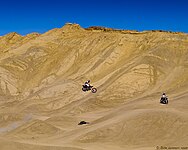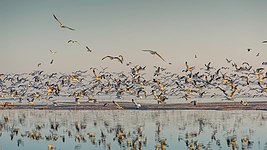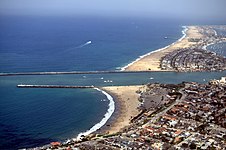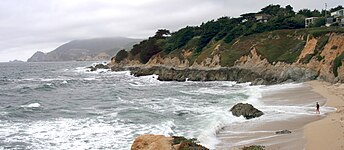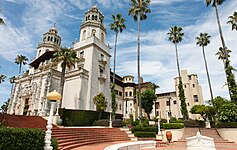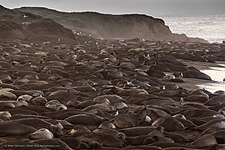California State Parks
| California Department of Parks and Recreation | |
 | |
| Agency overview | |
|---|---|
| Formed | 1864 (First State Park) 1927 (Bureaucratic Forming) [1] |
| Headquarters | 715 P St, Sacramento, California |
| Employees | 1,451 permanent staff, 1,416 seasonal (2016-17)[2] |
| Annual budget | $1.039 billion (2023)[3] |
| Agency executive |
|
| Parent agency | California Natural Resources Agency |
| Website | parks.ca.gov |
The California State Parks system (Spanish: Parques Estatales de California)[5] is the public park system of California. The system is administered by the California Department of Parks and Recreation, a department of the California Natural Resources Agency. The California State Parks system is the largest state park system in the United States.[6]
California State Parks administers 279 separate park units on 1.4 million acres (5,700 km2), with over 280 miles (450 km) of Californian coastline; 625 miles (1,006 km) of lake and river frontage; nearly 15,000 campsites; and 3,000 miles (4,800 km) of hiking, biking, and equestrian trails. Headquartered in Sacramento, park administration is divided into 21 districts.
History[edit]

California's first state park was the Yosemite Grant, which today constitutes part of Yosemite National Park. In 1864, the federal government set aside Yosemite Valley for preservation and ceded the land to the state, which managed the famous glacial valley until 1906.[citation needed]
California's oldest state park, Big Basin Redwoods State Park, was founded in 1902. Until 1921, each park was managed by an independent commission or agency.[citation needed]
In 1927, the California Legislature, with the support of Governor C. C. Young, established the State Park Commission,[7] and its original membership included:[8] Major Frederick R. Burnham, W. F. Chandler, William E. Colby (Secretary), Henry W. O'Melveny, and Dr. Ray Lyman Wilbur. The following year, a newly established State Park Commission began gathering support for the first state park bond issue. Its efforts were rewarded in 1928 when Californians voted nearly three-to-one in favor of a $6 million park bond act. In addition, Frederick Law Olmsted Jr. completed a statewide survey of potential park lands that defined basic long-range goals and provided guidance for the acquisition and development of state parks. With Newton B. Drury (later to be named director of the National Park Service) serving as acquisition officer, the new system of state parks rapidly began to grow.[9] William Penn Mott Jr. served as director of the agency under Governor Ronald Reagan.
In May 2008 The National Trust for Historic Preservation listed the park system as a whole on their list of America's Most Endangered Places.[10]
On January 10, 2008, Governor Schwarzenegger's office announced that the California State Park System will consider indefinite closures of all or part of 48 specific individual parks (one in five) to help meet the challenges of the looming (projected) $14.5 billion deficit facing California for its 2008-2009 budget year.[11] On September 25, 2009, Governor Schwarzenegger's office announced that all state parks would remain open during the 2009-2010 fiscal year using one-time budget reduction methods in maintenance, equipment, and services.[12]
A record wet winter in 2023 caused more than $210 million in storm damage to California's State Parks.[13]
Operation[edit]

Responsible for almost one-third of California's scenic coastline (280 miles), California State Parks manages the state's finest coastal wetlands, estuaries, beaches, and dune systems. California State Parks contains the largest and most diverse natural and cultural heritage holdings of any state agency in the nation. State park units include underwater preserves, reserves, and parks; redwood, rhododendron, and wildlife reserves; state beaches, recreation areas, wilderness areas, and reservoirs; state historic parks, historic homes, Spanish era adobe buildings, including museums, visitor centers, cultural reserves, and preserves; as well as lighthouses, caverns, ghost towns, water slides, conference centers, and off-highway vehicle parks.
These parks protect and preserve an unparalleled collection of culturally and environmentally sensitive structures and habitats, threatened plant and animal species, ancient Native American sites, historic structures and artifacts. The Department employs State Park Peace Officers Law Enforcement to protect and preserve the State Parks and the millions of people who visit them each year. Parks are patrolled by sworn State Park Peace Officers, of which there are two classifications, State Park Ranger and State Park Lifeguards.[citation needed]

Subdivisions of California State Parks include the California Office of Historic Preservation, Off-Highway Motor Vehicle Recreation Division, and the Boating & Waterways Division.
- Parks Forward Commission
The Parks Forward Commission was formed after the California Legislature called for the formation of a multidisciplinary advisory council to conduct an independent assessment and make recommendations.[14] The commission issued a report in 2015 that noted the lack of maintenance for many parks along with visitors who do not reflect the diversity of California's population. The report also said the agency is using outdated technology for managing the parks and providing reservations while being overwhelmed by the responsibility for managing the park system.[15]
Classification[edit]
The sites managed and preserved by the department are categorized into different types. There are 87 State Parks, 63 State Beaches, 51 State Historic Parks, 32 State Recreation Areas, 16 State Natural Reserves, 14 State Park Properties, 8 Vehicular Recreation Areas, 2 State Marine Reserves, 1 State Historical Monument, 1 State Seashore, and 1 Wayside Park.[citation needed]
The Public Resources Code provides the classification of units of the state park system. All units that are or will become part of the system, except those units or parts of units designated by the state legislature as wilderness areas or are subject to any other provision of law are classified by the State Park and Recreation Commission into one of these classifications.[16]
State Park[edit]
State Parks "consist of relatively spacious areas of outstanding scenic or natural character, oftentimes also containing significant [...] values. State recreation units "consist of areas selected, developed, and operated to provide outdoor recreational opportunities" and are classified as either State Recreation Areas, Underwater Recreation Areas, State Beaches, and Wayside Campgrounds.[16]
- State Parks in California
State Recreation Area[edit]
State Recreation Areas consist of "areas selected and developed to provide multiple recreational opportunities," and are selected for "having terrain capable of withstanding extensive human impact and for their proximity to large population centers, major routes of travel, or proven recreational resources." Underwater Recreation Areas consist of "areas in the nonmarine aquatic environment selected and developed to provide surface and subsurface water-oriented recreational opportunities..."
- State Recreation Areas in California
State Beach[edit]
State Beaches consist of "areas with frontage on the ocean or bays designed to provide beach-oriented recreational activities." Wayside Campgrounds consist of "relatively small areas suitable for overnight camping and offering convenient access to major highways." Historical units are "nonmarine areas established primarily to preserve objects of historical, archaeological, and scientific interest, and archaeological sites and places commemorating important persons or historic events." State seashores "consist of relatively spacious coastline areas with frontage on the ocean, or on bays open to the ocean [...] possessing outstanding scenic or natural character and significant recreational, historical, archaeological, or geological values."[16]
- State Beaches in California
State Historic Parks[edit]
State Historic Parks consists of 47 specially-designated historic sites across California, that highlight crucial events in the history of California and provide an educational opportunity for those interested in learning about Californian history, namely students.[17] These include battlegrounds, Californian missions, historic estates, cave paintings, and colonial fortifications, among others.
- State Historic Parks in California
State Reserve[edit]
State Reserves "consist of areas embracing outstanding natural or scenic characteristics or areas containing outstanding cultural resources of statewide significance," and are classified as either State Natural Reserves which consist of areas selected and managed to preserve their ecology, fauna, flora, geological features, and scenic qualities "in a condition of undisturbed integrity," or State Cultural Reserves which consist of areas selected and managed to preserve the integrity of historic structures and features as well as areas with spiritual significance to California indigenous people.[16]
- State Reserves in California
State Wilderness[edit]
State Wildernesses are areas where the environment has not been affected by humans and are relatively undeveloped state-owned or leased lands which have retained their original characters and influence or have been restored to a near-natural appearance. State wildernesses can be established within other state parks system units. Natural preserves are nonmarine areas of outstanding natural or scientific significance established within the boundaries of other units to preserve features natural features such as rare or endangered species and their supporting ecosystems. Cultural preserves are those established also within other units to preserve cultural features such as sites, buildings or zones important to the human history of California.[16]
- State Wilderness in California
State Marine Reserve[edit]
State Marine Reserves have a uniform classifications established by the Marine Managed Areas Improvement Act: State Marine Reserve, State Marine Park, State Marine Conservation Area, State Marine Cultural Preservation Area, and State Marine Recreational Management Area.[16]
- State Wilderness in California
See also[edit]
References[edit]
- ^ "State Parks Celebrating 150 Years. State of California". State Parks Celebrating 150 Years. State of California. Retrieved November 20, 2018.
- ^ "State Park System Statistical Report". CA.gov. State of California. Retrieved November 15, 2019.
- ^ California State Parks - 2023 Governor’s Budget
- ^ California State Parks - Director Armando Quintero
- ^ California State Parks - Adventure Pass Partner Toolkit (Spanish)
- ^ "Contact Us." California Department of Parks and Recreation. Retrieved on May 18, 2013.
- ^ "Climb the mountains and get their good tidings: A History of the Sierra Club". Archived from the original on September 18, 2006. Retrieved July 7, 2006.
- ^ Colby, William E.; Frederick Law Olmsted Jr. (April 1933). "Borrego Desert Park". Sierra Club Bulletin. XVIII: 144. Archived from the original on April 3, 2016. Retrieved July 29, 2007.
- ^ "A State Park System is Born". State of California. Retrieved July 28, 2007.
- ^ Threats to history seen in budget cuts, bulldozers - Yahoo! News Archived June 3, 2008, at the Wayback Machine
- ^ San Francisco Chronicle, "Governor's Budget Proposal: Parks" URL retrieved January 23, 2008.
- ^ "Gov. Schwarzenegger Announces Plan to Keep State Parks Open". Archived from the original on May 1, 2010. Retrieved May 3, 2010.
- ^ Castleman, Terry. "Record wet winter inflicted more than $210 million in damage to California parks". Los Angeles Times. Retrieved June 17, 2023.
- ^ Parks Forward
- ^ Megerian, Chris (January 29, 2014) "Panel urges transformation of California state parks system" Los Angeles Times
- ^ a b c d e f Classification of Units of the State Park System (Division 5 Parks and Monuments, Chapter 1 State Parks and Monuments, Public Resources Code, 1.7.). 1939.
- ^ California State Parks Foundation - California State Historic Parks: A window to the past





